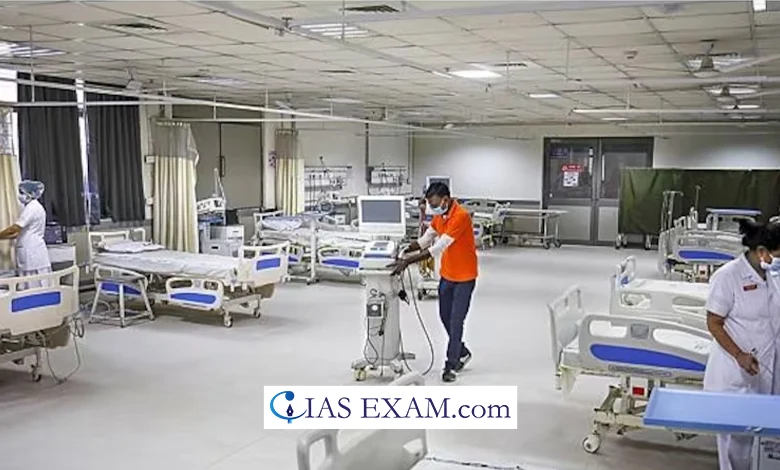Limiting the burden of Hospital Charges
GS Paper 2 - Health, Govt. Policies and Interventions

Context
The Supreme Court of India, while hearing a Public Interest Litigation (PIL) in February 2024, directed the Central Government to find ways to regulate the rates of hospital procedures in the private sector. The trigger for PIL and the directives were the high procedure rates and their large variations across the country in recent times.
The Court highlighted the problem using the procedure costs of cataract surgeries that cost only around Rs. 10,000 in a government set-up and between Rs. 30,000 to
Rs.1,40, 000 in private hospitals.
About Clinical Establishment Rules, 2012
- In exercise of the powers conferred by section 52 of the Clinical Establishments (Registration and Regulation) Act, 2010, the Central Government made the Clinical Establishments (Central Government) Rules, 2012.
- The officer of the rank of Joint Secretary dealing with the subject of Clinical Establishments in the Ministry of Health and Family Welfare, Government of India shall be the ex-officio Secretary of the National Council for clinical establishments established under sub-section (1) of section 3 of the Act.
- Every clinical establishment relating to diagnosis or treatment of diseases, where pathological, bacteriological, genetic, radiological, chemical, biological investigations or other diagnostic or investigative services, are usually carried on with the aid of laboratory or other medical equipment, shall comply with the minimum standards of facilities and services as specified in the Schedule.
- Every clinical Establishment shall display the rates charged for each type of service provided and facilities available, for the benefit of the patients at a conspicuous place in the local as well as in English language.
- The clinical establishments shall charge the rates for each type of procedure and services within the range of rates determined and issued by the Central Government from time to time, in consultation with the State Governments.
Reasons behind rising Healthcare Costs in India
- In an unregulated market-driven scenario, health-care providers focus on profit through higher prices and overprovision of care (supplier-induced demand). One potential solution, “yardstick competition”, involves regulatory authorities setting benchmark prices based on market observations.
- In India, over half the total health expenditure is OOP. The other half comes from a multitude of publicly and privately pooled resources. The private sector is predominantly composed of small-scale providers. Even if rates are standardized, their implementation will be uncertain.
- Command-and-control regulations through pecuniary measures such as price caps can swiftly influence actors’ behavior by making them follow the pronouncements. However, when enforcement mechanisms are weak, these effects are temporary because the overall environment remains unchanged.
- Design and implementation capacity constraints have hampered the effective adoption of the National Pharmaceutical Pricing Authority’s decision to cap the prices of stents and implants since 2017 and of the many directives that mandate doctors to prescribe generic medicines.
- Proliferation of the pharmaceutical industry has led to cheaper medicines for people across the world, but in India, the insidious growth of unscrupulous practices is taking a toll on the affordability of medicines.
Ways to prevent rise of Healthcare Costs in India
- As per the observations of the Supreme Court, pricing-related discussions must start with a benchmark for price determination. STGs can help establish relevant clinical needs, the nature and extent of care, and the costs of total inputs required.
- Rate standardization, through capped prices, may not address the fundamental problem of stakeholders’ misaligned incentives. A comprehensive health financing reform strategy informed by robust and ongoing research on appropriate processes for formulating and adopting benchmark standards must be in place.
- To finance medicines and avert margins of supply chain stakeholders, some states like Tamil Nadu and Rajasthan procure cheap unbranded generics from manufacturers and via centralized agencies sell it directly to the patients.
- It is also necessary to implement standard protocols to check irrational healthcare interventions, which are currently promoted on a wide scale due to commercial considerations.
- There is an urgent need to control commercialized private medical colleges, especially mandating that their fees must not be higher than government medical colleges. Further, expansion of medical education must be focused on public colleges rather than commercialized private institutions.
Way Forward
The Supreme Court’s remark presents an opportunity to develop effective mechanisms for addressing a key health-care system problem. Rate standardization rules must be realistic, simply implementable, and adhere to recognized price discovery methods. Future initiatives must build on recent and continuing health-care funding changes, address expected hurdles, and assure increased stakeholder involvement.
SOURCE: The Hindu





.png)



